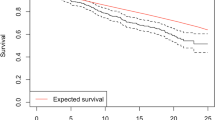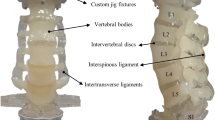Abstract
Purpose
The kinematical properties of C5/C6 segments in axial rotation are evaluated before and after total disc arthroplasty (TDA) with PRESTIGE®-and BRYAN® Cervical Disc (Medtronic) under flexion/extension as parameters and compared with those of C3/C4.
Methods
Eight human segments were stimulated by triangularly varying, axially directed torque (T z(t)) under compressing static axial preloads. Using a 6D-measuring device with high resolution, the response of segmental motion was characterized by the instantaneous helical axis (IHA). The position, direction, and migration path length of the IHA were measured before and after TDA (parameter: position of the axially directed preload).
Results
The periodic torque T z(t) generated IHA migrations whereupon the IHA direction was constantly rotated to the dorsal by ≈15.5°. After TDA, the IHA0 (neutral positions) were significantly shifted to the dorsal (PRESTIGE®: 4.3 mm, BRYAN®: 7.0 mm) just as the points of balance of the entire IHA migration paths.
Conclusions
Due to the configuration of the vertebral joints and their interaction with the intervertebral disc, the IHA migrates during the axial rotation within a distinct domain of each C5/C6-segment. Implantation of the PRESTIGE® and BRYAN® prostheses significantly alters these kinematical properties by dorsal displacements of the domains. Statistically TDA of C3/C4 and of C5/C6 are not correlated. Under axial rotation of the cervical spine, additional lateral and/or ventral/dorsal displacements are produced by TDA. Consequently, adjacent level disease (ALD) may be mechanically stimulated.








Similar content being viewed by others
References
Anderson PA, Sasso RC, Hipp J, Norvell DC, Raich A, Hashimoto R (2012) Kinematics of the cervical adjacent segments after disc arthroplasty compared with anterior discectomy and fusion: a systematic review and meta-analysis. Spine (Phila Pa 1976) 37:S85–S95. doi:10.1097/BRS.0b013e31826d6628
Shichang L, Yueming S, Limin L, Lei W, Zhongjie Z, Chunguang Z, Xi Y (2016) Clinical and radiologic comparison of dynamic cervical implant arthroplasty and cervical total disc replacement for single-level cervical degenerative disc disease. J Clin Neurosci 27:102–109. doi:10.1016/j.jocn.2015.05.072
Bartels RH, Donk RD, Pavlov P, van Limbeek J (2008) Comparison of biomechanical properties of cervical artificial disc prosthesis: a review. Clin Neurol Neurosurg 110:963–967
Chung SK, Kim YE, Wang KC (2009) Biomechanical effect of constraint in lumbar total disc replacement: a study with finite element analysis. Spine (Phila Pa 1976) 34:1281–1286
Fritsch EW, Pitzen T (2006) Cervical disc prostheses. Der Orthop 35:1097–1098
Sasso R, Martin L (2011) Bryan-Disk. In: Bertagnoli R, Yue JJ, McAfee PC, An HS (eds) Bewegungserhaltende Wirbelsäulenchirurgie. Elsevier, Munich, pp 111–117
Chen Y, Yuan W, Wu X, Chen H, Wang X, Yang L, He H, Liu Y, Tsai N, Peng Y, Gu S, Sun Q (2013) The effect of range of motion after single-level discover cervical artificial disk replacement. J Spinal Disord Tech 26:E158–E162. doi:10.1097/BSD.0b013e31828bc02f
Niederer D, Vogt L, Wilke J, Rickert M, Banzer W (2015) Age-related cutoffs for cervical movement behaviour to distinguish chronic idiopathic neck pain patients from unimpaired subjects. Eur Spine J 24:493–502. doi:10.1007/s00586-014-3715-y
Welke B, Schwarze M, Hurschler C, Book T, Magdu S, Daentzer D (2016) In vitro investigation of a new dynamic cervical implant: comparison to spinal fusion and total disc replacement. Eur Spine J 25:2247–2254. doi:10.1007/s00586-015-4361-8
Dugailly PM, Sobczak S, Sholukha V, Van Sint Jan S, Salvia P, Feipel V, Rooze M (2010) In vitro 3D-kinematics of the upper cervical spine: helical axis and simulation for axial rotation and flexion extension. Surg Radiol Anat 32:141–151. doi:10.1007/s00276-009-0556-1
Mansour M, Spiering S, Lee C, Dathe H, Kalscheuer AK, Kubein-Meesenburg D, Nagerl H (2004) Evidence for IHA migration during axial rotation of a lumbar spine segment by using a novel high-resolution 6D kinematic tracking system. J Biomech 37:583–592
Patwardhan AG (2010) IHA-Migration after TDA, lecture, German Spine Congress, Munich, Germany
Rousseau MA, Bradford DS, Hadi TM, Pedersen KL, Lotz JC (2006) The instant axis of rotation influences facet forces at L5/S1 during flexion/extension and lateral bending. Eur Spine J 15:299–307
Sengupta DK, Demetropoulos CK, Herkowitz HN (2011) Instant axis of rotation of L4-5 motion segment–a biomechanical study on cadaver lumbar spine. J Indian Med Assoc 109:389–390 (392–383, 395)
Wachowski MM, Hawellek T, Hubert J, Lehmann A, Mansour M, Dumont C, Dorner J, Raab BW, Kubein-Meesenburg D, Nagerl H (2010) Migration of the instantaneous axis of motion during axial rotation in lumbar segments and role of the zygapophysial joints. Acta Bioeng Biomech 12:39–47
Wachowski MM, Mansour M, Lee C, Ackenhausen A, Spiering S, Fanghanel J, Dumont C, Kubein-Meesenburg D, Nagerl H (2009) How do spinal segments move? J Biomech 42:2286–2293. doi:10.1016/j.jbiomech.2009.06.055
Wachowski MM, Wagner M, Weiland J, Dorner J, Raab BW, Dathe H, Gezzi R, Kubein-Meesenburg D, Nagerl H (2013) Does total disc arthroplasty in C3/C4-segments change the kinematic features of axial rotation? J Biomech 46:1739–1745. doi:10.1016/j.jbiomech.2013.03.027
Fanghänel J (2009) Ingredients of the preserving solution: Aqua dest, alcohol, glycerine, formalin, thymol, salicylic acid. Personal Communication
Weidl T (2003) Der Schwerpunkt einer Kurve. http://www.iadm.uni-stuttgart.de/LstAnaMPhy/Weidl/analysis/vorlesung-analysis/node244.html. Accessed 4 Nov 2016
Wachowski MM, Ackenhausen A, Dumont C, Fanghänel J, Kubein-Meesenburg D, Nägerl H (2007) Mechanical properties of cervical motion segments. Arch Mech Eng LIV 1:5–15
Nagerl H, Walters J, Frosch KH, Dumont C, Kubein-Meesenburg D, Fanghanel J, Wachowski MM (2009) Knee motion analysis of the non-loaded and loaded knee: a re-look at rolling and sliding. J Physiol Pharmacol 60(Suppl 8):69–72
Kubein-Meesenburg D, Nagerl H, Fanghanel J (1990) Elements of a general theory of joints. 1. Basic kinematic and static function of diarthrosis. Anatomischer Anzeiger 170:301–308
Nagerl H, Kubein-Meesenburg D, Cotta H, Fanghanel J, Rossow A, Spiering S (1995) Biomechanical principles in diarthroses and synarthroses. IV: the mechanics of lumbar vertebrae. A pilot study. Z Orthop Ihre Grenzgeb 133:481–491
Colle KO, Butler JB, Reyes PM, Newcomb AG, Theodore N, Crawford NR (2013) Biomechanical evaluation of a metal-on-metal cervical intervertebral disc prosthesis. Spine J 13:1640–1649. doi:10.1016/j.spinee.2013.06.026
Mansour M (2001) Die biomechanische Funktion der Articulationes zygapophysiales der Lendenwirbelsäule. Doctor Thesis, University of Göttingen
Acknowledgements
All authors disclose any financial and personal relationships with other people or organizations that could inappropriately influence our work. There are no employment, consultancies, stock ownership, honoraria, paid expert testimony, patent applications/registrations, and grants or other funding, which could influence any of the authors.
Author information
Authors and Affiliations
Corresponding author
Ethics declarations
Conflict of interest
The authors declare that they have no competing interest.
Rights and permissions
About this article
Cite this article
Wachowski, M.M., Weiland, J., Wagner, M. et al. Kinematics of cervical segments C5/C6 in axial rotation before and after total disc arthroplasty. Eur Spine J 26, 2425–2433 (2017). https://doi.org/10.1007/s00586-017-5073-z
Received:
Revised:
Accepted:
Published:
Issue Date:
DOI: https://doi.org/10.1007/s00586-017-5073-z




